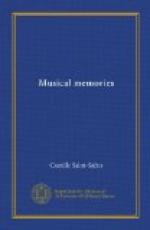[Illustration: Hector Berlioz]
We must remember that at this time Berton, who sang Quand on est toujours vertuex, on aime a voir lever l’aurore, passed for a great man. Beethoven’s symphonies were a novelty, in Paris at least, and a scandal. Haydn’s symphonies inspired a critic to write, “What a noise, what a noise!” Orchestras were merely collections of thirty or forty musicians.
We can imagine, therefore, the stupefaction and horror when a young man, just out of school, demanded fifty violins, twenty violas, twenty violoncellos, eighteen contrabasses, four flutes, four oboes, four clarinets, eight bassoons, twelve horns, and a chorus of two hundred voices as a minimum. And that is not all. The Tuba Mirum necessitates an addition of thirty-eight trumpets and trombones, divided into four orchestras and placed at the four cardinal points of the compass. Besides, there have to be eight pairs of drums, played by ten drummers, four tam-tams, and ten cymbals.
The story of this array of drums is rather interesting. Reicha, Berlioz’s first teacher, had the original idea of playing drum taps in chords of three or four beats. In order to try out this effect, he composed a choral piece, L’Harmonie des Spheres, which was published in connection with his Traite d’Harmonie. But Reicha’s genius did not suffice for this task. He was a good musician, but no more than that. His choral piece was insignificant and remained a dead letter. Berlioz took this lost effect and used it in his Tuba Mirum.
However, it must be confessed that this effect does not come up to expectations. In a church or a concert hall we hear a confused and terrifying mingling of sounds, and from time to time we note a change in the depth of tone but we are unable to distinguish the pitch of the chords.
I shall never forget the impression this Tuba Mirum made on me when I first heard it at St. Eustache under Berlioz’s own direction. It amounted to an absolute neglect of the author’s directions. The beginning of the work is marked moderato, later, as the brass comes in, the movement is quickened and becomes andante maestro. Most of the time the moderato was interpreted as an allegro, and the andante maestro as a simple moderato. If the terrific fanfare did not become, as some one ventured to call it, a “Setting Out for the Hunt,” it might well have been the accompaniment for a sovereign’s entrance to his capital. In order to give this fanfare its grandiose character, the author did not take easy refuge in the wailings of a minor key, but he burst into the splendors of a major key. A certain grandeur of movement alone can preserve its gigantesque quality and impression of power.
Granting all his good intentions, in trying to give us a suggestion of the last judgment by his accumulation of brass, drums, cymbals, and tam-tams, Berlioz makes us think of Thor among the giants trying to empty the drinking-horn which was filled from the sea, and only succeeding in lowering it a little. Yet even that was an accomplishment.




